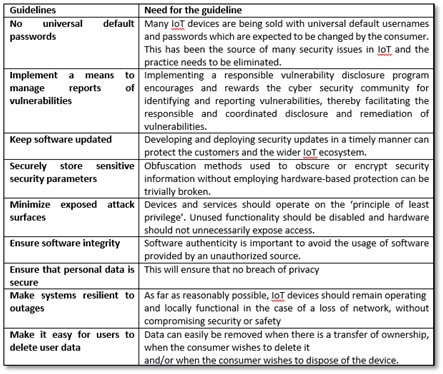Thursday, 6th January 2022
PM Security breach in Punjab
In New
- Prime Minister’s cavalcade was recently stranded on a flyover in Punjab due to protest by farmers.
About the News
- In a major security lapse, the PM’s cavalcade was recently left stranded on a flyover in Punjab’s Ferozepur district for over 15 minutes.
- PM had proceeded to travel by road after necessary confirmation of necessary security arrangements by the DGP Punjab Police.
- While the Ministry of Home Affairs has sought a report from Punjab government on the lapse in the security of the PM, the Punjab Chief Minister has blamed it due to sudden change of plan of PM visit.
What happened in Punjab?
- PM chose to travel by road because of bad weather in Punjab.
- The local police have to sanitise the entire route, placing snipers on rooftops on the route before the visit.
- Delay in communication channel has let the PM being totally exposed atop a flyover for over 15 minutes.
- Considering that Punjab is a state bordering Pakistan it was a serious security lapse as the local police failed to secure the entry and exit of the flyover.
How is the Prime Minister’s security planned?
- Planning of the PM’s security during any visit is an elaborate exercise that involves both central agencies and state police forces based on the guidelines in what is called the SPG’s ‘Blue Book’.
- Three days before any planned visit, the Special Protection Group (SPG), which is responsible for the PM’s security, holds a mandatory Advance Security Liaison (ASL) with everyone involved in securing the event, including SPG officials, Intelligence Bureau (IB) officials in the concerned state, state police officials, and the concerned district magistrate.
- Every minute detail of the visit and required security arrangements are discussed and an ASL report is prepared and signed by all those who attended according to which all the security arrangements are made.
What is the role of different security agencies?
- Role of SPG: It only provides proximate security to the PM and takes the final call on how the PM’s security is to be arranged. It doesn’t allow the PM to move unless it has got the go-ahead from the local police about the security of the route.
- Role of Central intelligence agencies: These are responsible for providing inputs about any threat to security.
- Role of state police: It ensures the overall security including intelligence gathering, route clearance, venue sanitisation, and crowd management besides conducting anti-sabotage checks, placing men on the roads and snipers on rooftops. The state police also provide a pilot vehicle that leads the PM’s cavalcade and, if the PM is likely to stay at a place, an officer of the level of superintendent of police (SP) is deputed as camp commandant to ensure security.
What are the major factors taken into consideration?
- Intelligence inputs: From central agencies and the local intelligence unit are taken into consideration.
- Security of the venue: Aspects such as entry and exit, frisking of those coming to the venue, placing of door frame metal detectors and structural stability of the dais is checked in advance.
- Safety norms: Fire safety of the venue is audited as well as the weather report for the day is taken into consideration if the PM is likely to take a boat to reach any place.
- Route mapping: SPG may ask to cut the bushes on the route of the PM, besides narrow patches of the route being mapped and more men asked to be posted there for route security.
What are the major issues during planning?
- Plans change suddenly: A contingency plan is always made in advance and an alternative route by road is planned with route being sanitised and security placed on the road.
- PM expected to go close to crowds of people: During public meetings, rallies, and road shows, apart from policemen, an SP-level officer is deputed to post men in plainclothes for security. However, it is the SPG which takes the final call no matter if the political team of the PM, or even the PM personally put pressure on his security personnel.
- Bad weather: An alternative route by road is planned in advance, the route is sanitised, and security placed on the road even if the PM is supposed to fly. If for any reason the route is found to be not clear, the state police do not give the go-ahead, the visit is cancelled.
- Spontaneous or unexpected protests that has not been anticipated during the planning: Protests are always a threat to any VIP’s visit and thus, elaborate advance planning factors in ways for the state police to thwart them. Generally, local intelligence has inputs on which groups are planning a protest and as preventive action the protesters are picketed in advance and both physical and electronic surveillance is mounted to gather information on such surprises. If there is a planned protest that cannot be stalled, then the route is avoided.
Sources:
China’s Border Law and India
In News: China’s Ministry of Civil Affairs had recently issued “standardised” names for 15 places in the Indian State of Arunachal Pradesh.
About the news:
- Of the 15 places, eight are residential places, four are mountains, two are rivers and one is a mountain pass.
- The naming had come ahead of a new land border law that took effect on January 1, 2022.
- This follows China’s 2017 attempt of assigning such names to places in the State.
- China’s persistent policy of renaming places is a result of China claiming that it did not consent to the Simla Convention of 1914.
- According to them Tibet had no independent authority to enter into an International agreement being a part of Chinese territory.
- India has however asserted that Arunachal Pradesh has "always been" and will "always be" an integral part of India and that assigning "invented" names does not alter this fact.

Understanding the New Law:
- To protect the land border areas: The Law is claimed to have been passed for the “protection and exploitation of the country’s land border areas”.
- To protect the sovereignty: Under the law, the sovereignty and territorial integrity of China are considered sacred and inviolable, and it mandates the state to take measures to safeguard its land boundaries and combat any act that undermines these.
- To Safeguard Civilians: It encourages the development of villages for civilians in the border areas.
- To handle border disputes: It also urges the state to follow the principles of equality, mutual trust, and friendly consultation, handle land border related affairs with neighbouring countries through negotiations and resolve disputes and longstanding border issues.
Claimed Reasons/Factors leading to such law:
- China’s concerns over the security of its land border as it already confronts a slew of unsettled disputes on its maritime front.
- China’s worries about the spread of terrorism via Afghanistan (which witnessed the recent withdrawal of the US forces and Taliban takeover) as China’s hinterland borders Central Asia.
- Domestic politics too may have been a contributing factor for the passage of the law.
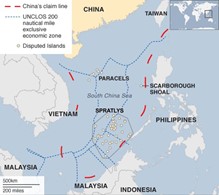
Impact on India-China Relations and India’s Concerns:
- The broader aim of the land border law according to India, is to give legal cover and formalise the Chinese military’s transgressions across the LAC in 2020.
- China and India share a disputed 3,488-km boundary, the third longest among China’s 22,457-km land boundaries with 14 countries, after the borders with Mongolia and Russia.
- Besides India, Bhutan (477 km) is the only other country with which China has a disputed land border.
- Apart from Patrolling Point 15 (PP15), China is blocking Indian troops from accessing its traditional patrolling limits—PP10, PP11, PP11A, PP12 and PP13—in Depsang Plains. Also, certain “so-called civilians” have pitched tents on the Indian side of the LAC in Demchok and are refusing to vacate it.
- The new law prohibits construction of permanent infrastructure close to the border without China’s permission.

Source:
Image Source:
NEAT 3.0
In News
Ministry of Education (MoE) launches NEAT 3.0, a single platform to provide best-developed ed-tech solutions and courses to students.
National Educational Alliance for Technology (NEAT)
- NEAT is an initiative of MoE to provide a platform of learning in upcoming and state of art technology areas through online products being offered by industry.
- NEAT is envisaged as a Public-Private partnership model between the Government (through its implementing agency AICTE) and the Education Technology companies of India.
How does NEAT work?
- Through an open invitation and screening, companies are invited to showcase their best-developed technological solutions in the education sector on a National Portal developed for the learners.
- Learners may procure these solutions based on their requirements.
- These solutions use Artificial Intelligence for a personalized and customized learning experience for better learning outcomes and skill development in the niche areas.
- AICTE is acting as the facilitator in the process while ensuring that the solutions are freely available to a large number of socially and economically backward students.
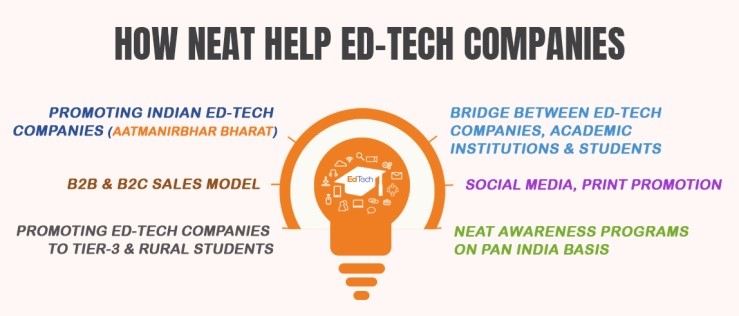
Aim of NEAT
- The aim of NEAT is to bring the best technological Products in education pedagogy on a single platform for the convenience of learners.
- This would enhance the employability of the youth by imparting them the highly employable skills.
- NEAT will be a game-changer in bridging the digital divide, especially among the economically disadvantaged students and also in fulfilling the knowledge-based requirement of India and the world.
- More than 12 lakh socially and economically disadvantaged students have received free ed-tech course coupons worth over ₹253 crore under NEAT 3.0.

Sources:
World Day of War Orphans
The World Day of War Orphans is observed on January 6 every year. The day aims to raise awareness about children who have been orphaned due to wars. The objective of the day ensures to voice out the predicament of war orphans and highlight the emotional, social, and physical challenges children face while growing up. The World Day of War Orphans was initiated by the French organization, SOS Enfants en Detresses. Displaced children are a big part of IDPs (International Displaced Persons) who are forced to leave everything - including their homes, places of work, and possessions. According to unicef.org, "There were nearly 140 million orphans globally in 2015, including 61 million in Asia, 52 million in Africa, 10 million in Latin America and the Caribbean, and 7.3 million in Eastern Europe and Central Asia."
Quote: "There are many in the world dying for a piece of bread, but there are many more dying for a little love." -Mother Teresa

Source:
Toyconomy: Understanding India’s Toy Industry
In News
The government has recently informed the Parliament that the import of toys into India has shown a decreasing trend in the last three years.
Current Status of Toy industry in India
- Increasing economic Value: The Indian toys market reached a value of US$ 1.23 Billion in 2020.
- Consistent growth: Indian toys market is expected to grow at a CAGR of 12.2% during 2021-2026.
- Large MSME presence: Indian toy sector comprises 8,366 registered manufacturing MSMEs.
- Predominance of imports: India has been importing toys largely from China (about 3/4th of total imports). However, a gradual decline in imports has been recorded in the past three years.
- Small global share: While the global toy industry is over ₹7 trillion, India's share is very small.
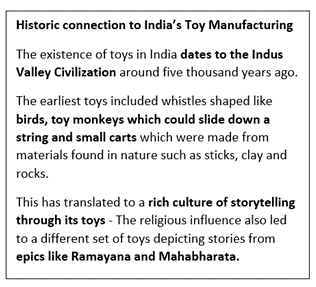
Why should we focus on India’s toy industry?
Toys are not single-use consumable goods. The effect that they have on children remains relevant even after the economic transaction is over. In this context, toy industry assumes importance in economic as well as social realm-
- Economic opportunities:
- Huge consumer base: The country has a very large young population with around half of the total population under the age of 25, creating a large platter of potential consumers.
- Some reports suggest that India’s toy market has the potential to double to $2 billion by 2025.
- Growing demand with rise of the middle class: Growing demand and decreasing cost of production has resulted in a major shift from traditional, medium- to low-end battery-operated toys, towards innovative electronic toys, intelligent toys.
- High employment generating sector: Large MSME presence in the sector has the potential to generate large employment through artisans, small traders and MSME manufacturers.
- As a corollary to MSME growth, growth in Toy Manufacturing sector in tier-II and tier-III markets has also been witnessed.
- Emergence of digital marketplace: Growth of E-commerce has helped overcome the logistical difficulties and has expanded the reach of local and traditional toy markets.
- Growth of E-commerce has indirectly increased the export potential of local manufacturers who can now compete in the global markets.
- Huge consumer base: The country has a very large young population with around half of the total population under the age of 25, creating a large platter of potential consumers.
- Societal opportunities:
- Growing educational toys market: Toys have an impact on overall development of a child. E.g.: motor, psychomotor, cognitive skills and also stimulate creativity.
- Shaping the value system: Toys bring to life society’s traditions, beliefs, values, and ethos and thus can act as an agent of propagation of the ethics and progressive value systems. E.g., using dolls for breaking gender stereotypes.
- Increasing cultural awareness: Toys can be used to increase curiosity in histories, mythology etc. by recreating cultural characters. E.g., gradual movement of children from ‘Mickey Mouse’ playing cards to ‘Chota Bheem’ playing cards.
To complement these large opportunities, India already has a vibrant toy culture.
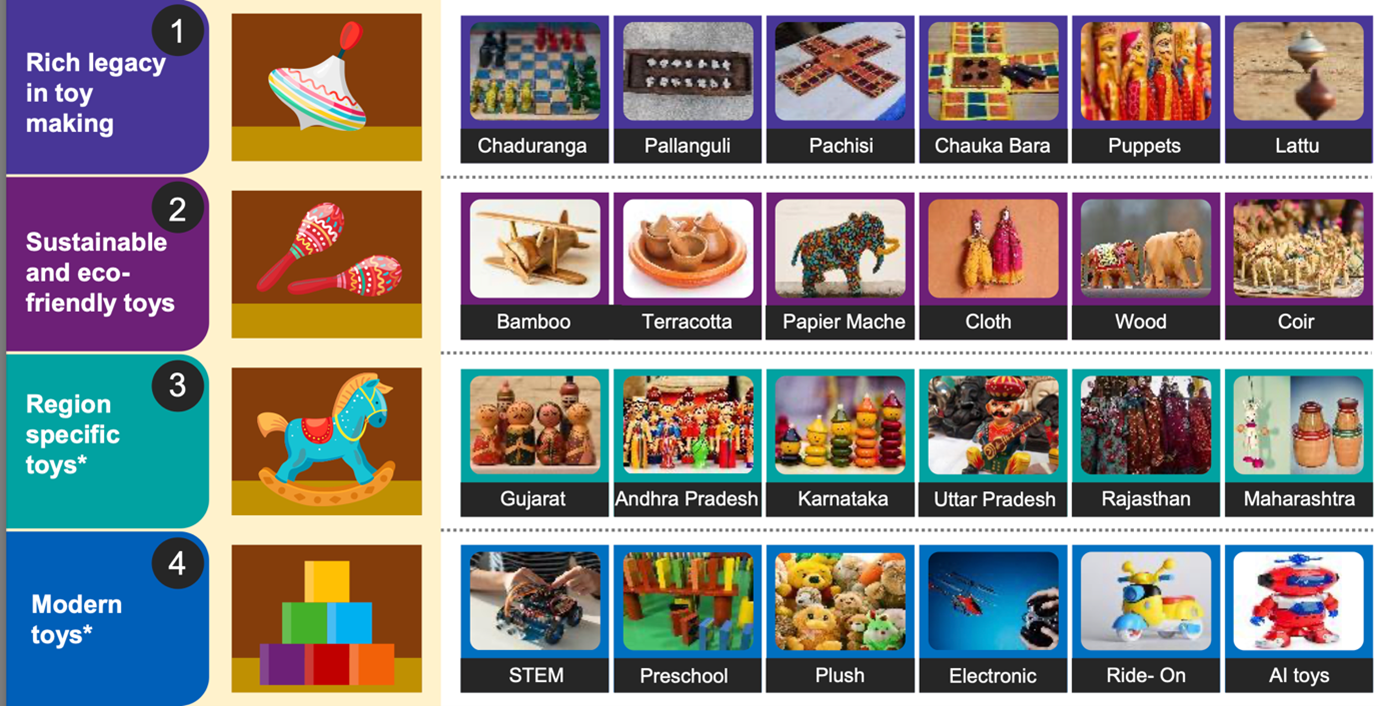
Steps taken by government exploit this potential
- Indigenous toy clusters: Several Toy clusters have been approved under Scheme of Fund for Regeneration of Traditional Industries (SFURTI) scheme such as Lucknow Soft toys cluster and Wood craft cluster of Jodhpur.
- National Toy Action Plan: The Government of India, by involving 15 ministries has prepared a National Toy Action Plan to make Indian toy industry competitive. It is a big Make in India push for domestic manufacturing of toys.
- The formation of National Toy Action Plan, Vocal for Local and Make in India are likely to benefit domestic toy manufacturers.
- Product Specific Industrial Cluster Development Programme: aims to build toy clusters in dedicated SEZs to help them become self-sustained ecosystems catering to export markets.
- Other initiatives taken by the Government:
- First-of-its-kind Virtual India Toy Fair 2021 was organized.
- “Toys” identified as one of the key sectors under Aatmanirbhar Bharat Abhiyan.
- Toycathon-2021 was launched to challenge India’s innovative minds to conceptualize novel toy and games based on Indian civilization, history, culture, mythology, and ethos.
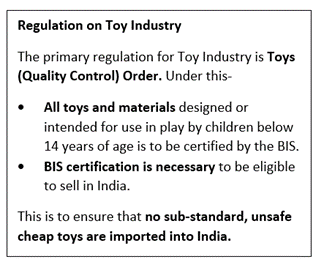
What are the persisting Challenges?
- Limitations manufacturing facilities: Poor infrastructure and absence of end-to-end manufacturing facilities hinders the sector’s growth.
- Economies of scale issue: Toy manufacturing economies significantly depend on large production for profitability and thus requires high investment and continuous demand, which is unavailable in emerging markets like India.
- Absence of skilled labour: Toy manufacturing requires specific skillsets which are unavailable in India’s predominantly unskilled labour.
- Fragmented market: India’s toy market is largely fragmented with limited linkages between local artisans, manufacturers and marketing agents such as local traders.
- Technological challenges: With evolution of gaming industry, demand for manufacturing of digitally high end toys is growing. But this requires technological skillsets which are either unavailable or unaffordable to the local industry.
Way Forward
- Enhancing manufacturing competitiveness by addressing the raw the material issues, streamlining the GST input credit structure and overcoming the supply chain issues.
- Skilling & R&D to bridge the persistent gap in demand and supply: Development of toy design centres with focus on R&D to encourage innovation, incentivizing technical institutes to offer specialized courses in toy and game design and incentivizing knowledge mobility across institutions.
- Improving Ease of doing business through a one-stop shop like “National Creative Hub (C-Hub)”, improving digital preparedness and leveraging the growing start-up ecosystem.
- Tech collaboration need of the hour: Strategic relationships with global players to leverage Science, Technology, Engineering, Art and Math toys.
- Building a “Playful, Creative and Innovative Economy”: Leveraging National Education Policy 2020 to push local artisans and promoting initiatives like toy-based tourism, Local “Toy Banks” and “Toy Library” models.
- Testing and certification: Developing a standard norm and increasing the number of labs in testing and certification and expanding geographic coverage of these labs.
Question: Discuss the potential of the toy industry in India. What are the challenges in achieving this target?
Sources:
- Toy imports fell in last 3 years: Govt to Parliament
- making-headway---toy-manufacturing-sector-in-india.pdf
- Must introspect why we can’t reach China’s global share in toy industry’
- No child’s play: Are domestic manufacturers benefitting from India’s declining toy imports?
- Toys Manufacturing Creating India's Toy Story
- Indian toy industry: A step towards self-reliance
- India's toy market has potential to double to $2 bn by 2025: Report
- India’s toy story – Unboxing fun and beyond
- ABOUT INDIAN TOYS
- 'Toyconomy': Has new regulation translated into growth for toy industry?
- Explained: Why India's toy market faces looming shortage
- Indian Toys Market: Industry Trends, Share, Size, Growth, Opportunity and Forecast 2021-2026
- Toy imports decline in 3 years as India registers 8k MSMEs for manufacturing
- How Toy Industry is Evolving in India
- No child’s play: India’s potential to tap into the global toy market
- Toys in PLI scheme will make sector competitive’
- Toy Story Promotion of Indigenous toys of India
China's longest underwater highway tunnel
This is image of China's longest underwater highway tunnel is now open to vehicle traffic. At a length of 10.79 kilometers (6.65 miles), the Taihu tunnel stretches under Lake Taihu in eastern China's Jiangsu Province, about 50 kilometers east of Shanghai. Over 2 million cubic meters of concrete were used to build the two-way tunnel, which has six lanes and is 17.45 meters wide. The ceiling of the tunnel has been outfitted with colorful LED lights, designed to prevent driver fatigue. The world's longest underway highway tunnel is Norway's 14.3-kilometer twin-road Ryfast tunnel, which runs between the city of Stavanger and the municipality of Strand. In terms of underwater tunnels in general, though, the top honor goes to the Channel Tunnel, which connects England and France by rail. Its submerged portion runs for 37.9 kilometers, the longest of any underwater tunnel in the world.
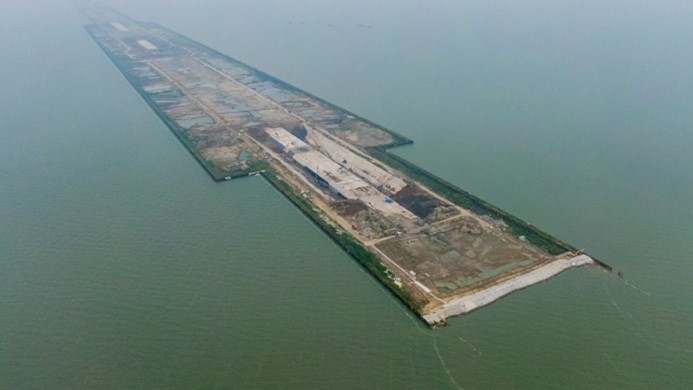
Source:
Olive Ridleys
- Context: A study was recently carried out to assess the incubation temperature of Olive Ridley nests along the coast of Maharashtra.
- The Olive ridleys are the smallest and most abundant of all sea turtles found in the world.
- They are commonly found in warm tropical currents of the Indian and Pacific oceans.
- The Odisha’s Gahirmatha Marine Sanctuary is known as the world’s largest rookery (colony of breeding animals) of sea turtles.
- They are categorized as ‘Vulnerable’ in the IUCN Red list and are listed under Schedule I of the Wildlife Protection Act, 1972 and Appendix I of the CITES.
- They are best known for their unique mass nesting called Arribada, where thousands of females come together on the same beach to lay eggs.
- They face threats that include Marine pollution and waste, human hunting for consumption, trawlers etc.
- The Indian Coast Guard undertakes the Olive Ridley Turtle protection program-'Operation Olivia' every year.

Source:
Image Source:
Ayush Aaahar
- Context: Ministry of AYUSH has launched ‘Ayush Aahaar' in Delhi.
- Ayush Aahaar is an initiative that aims to promote healthy living through nutritional diet.
- Started as a pilot project, it includes Vegetable Poha, Bhajani Vada, Gajar Ka Halwa and Kokum Drink that have high nutritional value.
- This Ayush diet is beneficial for health and easily digestible.
- The campaign will eventually help to create awareness among public regarding health benefits associated with region specific Ayurvedic Aahar to achieve and maintain good health.
- Ayush is a traditional & Non-Conventional Systems of Health Care and Healing which Include Ayurveda, Yoga, Naturopathy, Unani, Siddha, Sowa-Rigpa and Homoeopathy.
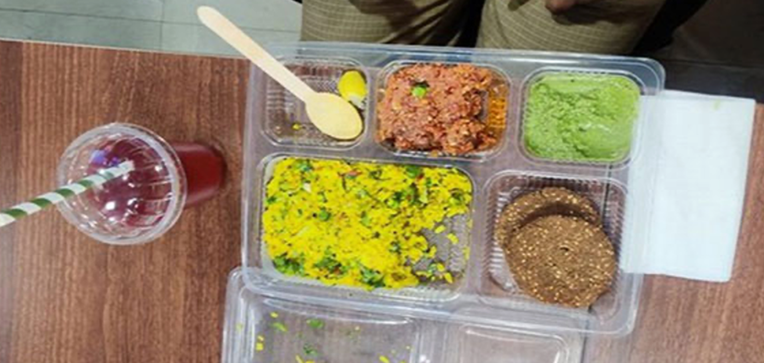
Source:
- Ministry of Ayush makes ‘Ayush Aahaar’ available at its canteen
- AYUSH Ministry Introduces 'Ayush Aahaar' In Canteen To Promote Healthy & Nutritional Diets
Image Source:
Domestic Systemically Important Insurers
- Context: Insurance Regulatory and Development Authority of India (IRDAI) has recently identified state-owned LIC, GIC Re and New India as Domestic Systemically Important Insurers (D-SIIs) for 2021-22.
- D-SIIs are perceived as insurers that are ‘too big or too important to fail’ (TBTF).
- They refer to insurers of such size, market importance and domestic and global interconnectedness whose distress or failure would cause a significant dislocation in the domestic financial system.
- Healthy functioning of D-SIIs is mandatory for the uninterrupted availability of insurance services to the economy.
- Thus, there is a need to subject them to additional regulatory measures to deal with the systemic risks and moral hazard issues.
- LIC is the largest insurer in the country, GIC Re is the country's sole reinsurer, while New India is the country's largest general insurance company.
- IRDA is the apex body that supervises and regulates the insurance sector in India.
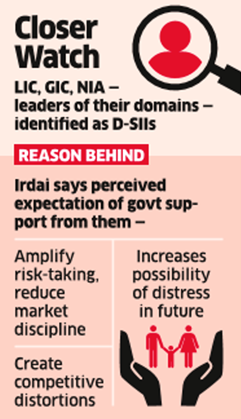
Source:
- LIC, GIC Re and New India systemically important insurers: IRDAI
- What is IRDAI? Functions of IRDA
- LIC, GIC Re and New India are systematically important insurers for 2020-21
Image Source:
Inner Line Permit
- Context: The Supreme Court has agreed to hear a PIL challenging the Inner Line Permit (ILP) System in Manipur.
- Implemented under the British-era Bengal Eastern Frontier Regulation, 1873, the ILP is an official document issued to let an Indian citizen enter a protected area for a limited period.
- Indian citizens from other states must possess ILP in order to enter states like Arunachal Pradesh, Mizoram, Nagaland and Manipur (added in 2020).
- It is issued by the concerned State Government solely for travel purposes.
- The main aim of ILP is to prevent settlement of other Indian nationals in these States in order to protect the indigenous/tribal population and their resources.
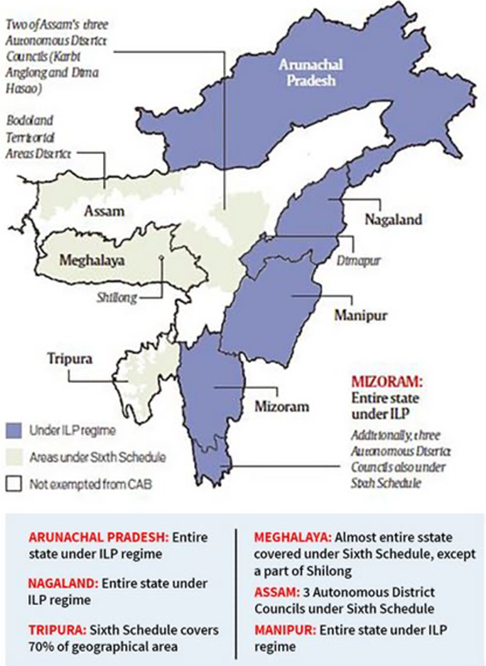
Source:
Climate funds: Developed nations must step up
Essence: The issue of Climate finance needs to be paid more attention especially after world saw extreme events both hydro-meteorological as well as climatological. The commitment of $100 billion a year by developed countries towards developing and vulnerable countries remained elusive during all this time. Moreover, now the developed nations are coercing developing nations into committing to an unreasonable target of reducing carbon emissions to net-zero by mid-century.
A disconnect is caused both in needs as well as the estimations on funds disbursed by the developed nations due to lack of standard methodology. Such inconsistency in estimating international climate finance arises primarily because of two key issues related to the taxonomy of international climate finance: Clubbing development finance with climate finance and counting private finance as financial support. Another concern is low allocations for climate adaptations and higher allocation towards mitigation as highlighted by the United Nations Environment Programme (UNEP), in its Adaptation Gap Report in 2016. To make up for the shortfall and fulfilment of internationally agreed climate objectives by 2030, the developed countries must take immediate action. Firstly, there should be clarity and consensus on the definition of International Climate finance to avoid the possibility of greenwashing. Secondly, more funds towards climate adaptation finance. A distinction between development and climate finance is vital. More funds are needed for climate adaptation projects. Thirdly, need based allocation of climate finance especially towards climate change vulnerable nations such Pacific Island Countries (PICs), Small Island Countries (SIDs), and Least Developed Countries (LDCs) are disproportionally affected by climate change. Fourthly revision of $100 billion target to reflect the real requirements.
Why you should read this article?
- The article gives an insight towards the shortfalls of current climate finance mechanisms.
- The article suggests ways to revamp and revise the current strategies to address the issue of climate finance.
Source:
How to build a green infrastructure grid
Essence - The article highlights the need for leaving India’s obsession to developing highways in the name of infrastructure development. India should rather focus on improving the existing infrastructure which could streamline the process of building world class logistic process in India. Building new charging stations for electric vehicle along with smarter signaling system will ensure faster movement of rails and cargos.
At the same time focus should be to make intermediate transport system electrically powered along with investing on robust water infrastructure. All such steps will not only make India climate resilient but will also help in accelerating Covid-19 recovery. Refurbishing existing infrastructure is like low hanging fruits which has a benefit of providing quick start and quick recovery. Investment in new projects can take care of sustained growth in the long term period.
Why you should read this article?
- To understand the lacunas in the infrastructure development in the country.
- To understand that how taking little steps in infrastructure development can accelerate covid 19 recovery.
Source:
High Stakes Afghan Game- Tribune
Essence: The editorial focuses on the security and international policies’ dimension of Pakistan and its claims of comparisons with its neighbors. Pakistan has involved itself with domestic issues of Afghanistan, calls itself at economic parity with India and attempts to speak of itself as far better than Bangladesh. In addition, it has supported Taliban’s terror, as opposed to USA’s demand from Taliban.
On the other hand, Pakistan’s economy is reeling with burden, its dubious stand on terrorism is wide open in the international arena. India, as a neighbor has done well to avoid military confrontation with respect to Afghanistan but Pakistan faces indirect hints from multiple sources to establish peace and improve its internal and external affairs.
Why you should read this article?
- To understand the policies of Pakistan with respect to Afghanistan and how Pakistan has its rhetoric for its neighbors.
- To gain an insight into Pakistan’s neighbors and how they mold Pakistan’s international viewpoint.
Source:
Story of immense courage and determination- Dr. Sindhutai Sapkal (Mai)
Background: Eminent social worker and Padma Shri awardee Sindhutai Sapkal, passed away on 5th Jan 2022 at the age of 73, and who was renowned for her tireless work for the society.
Sapkal, who hailed from a backwaters village in Wardha district, adopted was ‘simple living and high thinking’.
Being a woman she was no way away from facing the discrimination- she transcended the tribulations of her early life, which included making rotis near a crematorium to feed her baby, in a manner that few individuals do. She sublimated her pain and suffering into devoting the rest of her life to bestowing affection on orphaned children. She also fought for the basic ‘Rights of Tribals’ as well as depressed women.
Her Mission: To bring up the orphans, destitute, distressed, children and women rehabilitation and provide them with basic necessities. To uplift the deprived section of the society and make them capable to live as respected human being.
Her Achievements: Sahyadri Hirkani Award; Rajai Award; Shivlila Mahila Gaurav; Ahmadiya Peace Prize and many more than 750 awards.
Quote: “You have two hands one to help self and the other to help Others..!”
- Dr Sindhutai Sapkal
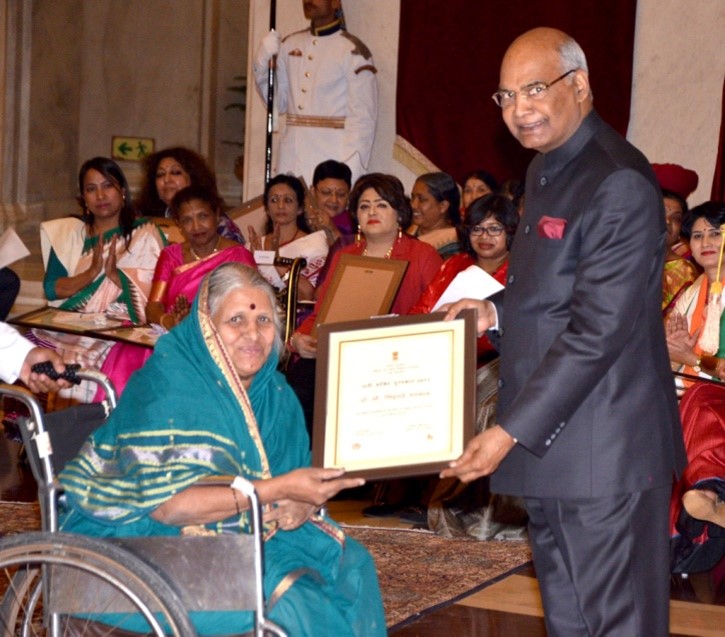
Sources:
Share the article
Get Latest Updates on Offers, Event dates, and free Mentorship sessions.

Get in touch with our Expert Academic Counsellors 👋
FAQs
UPSC Daily Current Affairs focuses on learning current events on a daily basis. An aspirant needs to study regular and updated information about current events, news, and relevant topics that are important for UPSC aspirants. It covers national and international affairs, government policies, socio-economic issues, science and technology advancements, and more.
UPSC Daily Current Affairs provides aspirants with a concise and comprehensive overview of the latest happenings and developments across various fields. It helps aspirants stay updated with current affairs and provides them with valuable insights and analysis, which are essential for answering questions in the UPSC examinations. It enhances their knowledge, analytical skills, and ability to connect current affairs with the UPSC syllabus.
UPSC Daily Current Affairs covers a wide range of topics, including politics, economics, science and technology, environment, social issues, governance, international relations, and more. It offers news summaries, in-depth analyses, editorials, opinion pieces, and relevant study materials. It also provides practice questions and quizzes to help aspirants test their understanding of current affairs.
Edukemy's UPSC Daily Current Affairs can be accessed through:
- UPSC Daily Current Affairs can be accessed through Current Affairs tab at the top of the Main Page of Edukemy.
- Edukemy Mobile app: The Daily Current Affairs can also be access through Edukemy Mobile App.
- Social media: Follow Edukemy’s official social media accounts or pages that provide UPSC Daily Current Affairs updates, including Facebook, Twitter, or Telegram channels.

